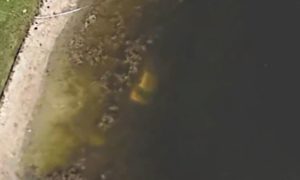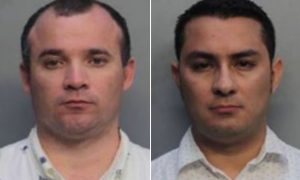Illinois law enforcement authorities will need court approval to use cell phone trackers like StingRay that can sweep up data from innocent citizens, according to a new state law.
The ACLU of Illinois said the law, signed on Friday, is “as far-reaching and comprehensive as anywhere in the county.”
“There’s a growing sense of awareness in the legislature that these privacy issues are really important,” said Ed Yohnka, spokesman for the ACLU of Illinois.

This undated handout photo provided by the U.S. Patent and Trademark Office shows the StingRay II, manufactured by Harris Corporation, of Melbourne, Fla., a cellular site simulator used for surveillance purposes. Photo Credit: Associated Press
The new Citizen Privacy Protection Act requires law enforcement in most cases to obtain a warrant before using StingRay, a device capable of extracting information like location, contact lists, text messages and incoming and outgoing call data. Law enforcement must tell the court who they’re looking for and how they plan to tailor the technology so that it doesn’t target unintended citizens.
“One of the things we now know is that if a StingRay is used at an event publicly because of one person, police are required to delete information about everyone else who was there,” Yohnka said.
Privacy advocates complain that the StingRay and similar devices capture data from all cell phones in its range, not simply the intended target. The Illinois law will require police to delete this extraneous user data at least every 24 hours.
Police say the technology is valuable because it can help pinpoint the location of a kidnapper or fugutive, for example.
“If police are tracking a particular suspect and they think they’re inside of a certain home or apartment, they can track them pretty closely.” Yohnka said.
Privacy advocates, however, liken the technology to an unlawful digital “stop and frisk.” Chicago demonstrators have accused police of using the technology to spy on their protest activities and say they fear officials will use the data to build a database of protesters.

A protester faces off with a Chicago police officer during an anti-NATO protest march in Chicago May 19, 2012. Hundreds of demonstrators protested peacefully on Saturday on the eve of the NATO summit in Chicago. Photo Credit: Reuters
Devices like StingRay and a competitor called Triggerfish are known as cell tower site simulators, or “International Mobile Subscriber Identity catchers.” They’re about the size of a suitcase, so they can be concealed in a police vehicle, aircraft or carried by an individual.
When a StingRay is activated, it mimics a cell tower by broadcasting a strong signal that tricks nearby cell phones into connecting to the surveillance device and releasing location data. Once the StingRay drops the cell phone signal, the phone reconnects with a legitimate cell tower.
Phone users may notice when a cell tower site simulator is nearby. Typical signs are rapid battery drain, difficulty sending or receiving text messages and calls, difficulty connecting to the internet, and sometimes a phone shutting down.
The surveillance technology was originally designed for the military and is widely used by federal investigative agencies, including the Drug Enforcement Administration, Secret Service, Immigration and Customs Enforcement, and the U.S. Marshals Service. The ACLU says police in at least 24 states and the District of Columbia also have cell tower site simulators.
“Once the manufacturers has exhausted their opportunities to sell it to the federal government, they’ve started selling it to local governments,” said Matt Topic, a Chicago civil rights attorney.
Topic represents Freddy Martinez, a Chicago-area tech expert who is suing the Chicago Police Department for its refusal to comply with open records requests concerning the use of StingRay.
The department, like many others, has been reluctant to admit it has a StingRay, let alone uses it. Legal experts have been troubled by some police departments apparently misleading judges or omitting information from warrant requests about how the technology is deployed.
Illinois’ law drew bipartisan support as it unanimously passed the state legislature this year. State and local police were neutral on the bill and did not comment when Gov. Bruce Rauner (R) signed the measure into law. It takes effect Jan. 1.
Topic praised the new law, but said it falls short of protecting citizens’ privacy.
“The way the technology works is that it intrudes into everyone’s phone in the area, and that hasn’t been really addressed,” Topic said. “You’d still have a Fourth Amendment problem as soon as the invasion occurs.”
He said he favors an outright ban on the technology.
“To me that would be the best protection.”
Source: HuffPost














































































































































































































































![[Video] Chicago Police Officers Caught On Video Telling Two Black Men "We Kill Mother F**kers"](https://earhustle411.com/wp-content/uploads/2018/07/evil-cop-3-300x180.jpg)
![[Video] Chicago Police Officers Caught On Video Telling Two Black Men "We Kill Mother F**kers"](https://earhustle411.com/wp-content/uploads/2018/07/evil-cop-3-80x80.jpg)












![[Video] White Woman Calls The Cops On Black Real Estate Investor, Cops Threaten To Arrest Her For Harassing Him](https://earhustle411.com/wp-content/uploads/2018/05/nosy-neighbor-300x180.png)
![[Video] White Woman Calls The Cops On Black Real Estate Investor, Cops Threaten To Arrest Her For Harassing Him](https://earhustle411.com/wp-content/uploads/2018/05/nosy-neighbor-80x80.png)


![White Scientist Says The Black Community Is Being Targeted By The Medical System, They Are Deliberatly Being Poisoned [Video]](https://earhustle411.com/wp-content/uploads/2016/05/mike-adams-300x180.jpg)
![White Scientist Says The Black Community Is Being Targeted By The Medical System, They Are Deliberatly Being Poisoned [Video]](https://earhustle411.com/wp-content/uploads/2016/05/mike-adams-80x80.jpg)








![Teenage Girl Shot In Her Stomach Three Times But Took Time To Post To Facebook [ Video]](https://earhustle411.com/wp-content/uploads/2016/02/Gangster-chick-300x180.jpg)
![Teenage Girl Shot In Her Stomach Three Times But Took Time To Post To Facebook [ Video]](https://earhustle411.com/wp-content/uploads/2016/02/Gangster-chick-80x80.jpg)







